DJI Mavic 3
Two-minute review
The DJI Mavic 3 is the most powerful folding drone the company has made so far – and in pure performance terms, it's also the best. But the big improvements over the DJI Mavic 2 Pro come with a cost. This means that for most non-professionals, the smaller and more affordable DJI Air 2S is the better all-round buy.
The highlight of the DJI Mavic 3 is undoubtedly its new dual-camera, which features two individual sensors and lenses. Impressively, the main camera houses a 20MP Four Thirds CMOS sensor with adjustable aperture – and this provides the best image quality in its class. The drone's second telephoto lens is much more limited, lacking manual controls or raw shooting, but is an occasionally useful alternative for capturing distant subjects.
The Mavic 3 is available in two versions – the Standard and the Cine. The main difference between the two, price aside, is that Cine features a built-in 1TB SSD rather than 8GB of internal storage, with support for Apple ProRes 422 HQ video recording. We used the Cine Premium Combo for this review, which offers all of the same flight and stills photography features as the standard version, with the exception being the ability to shoot Apple ProRes.
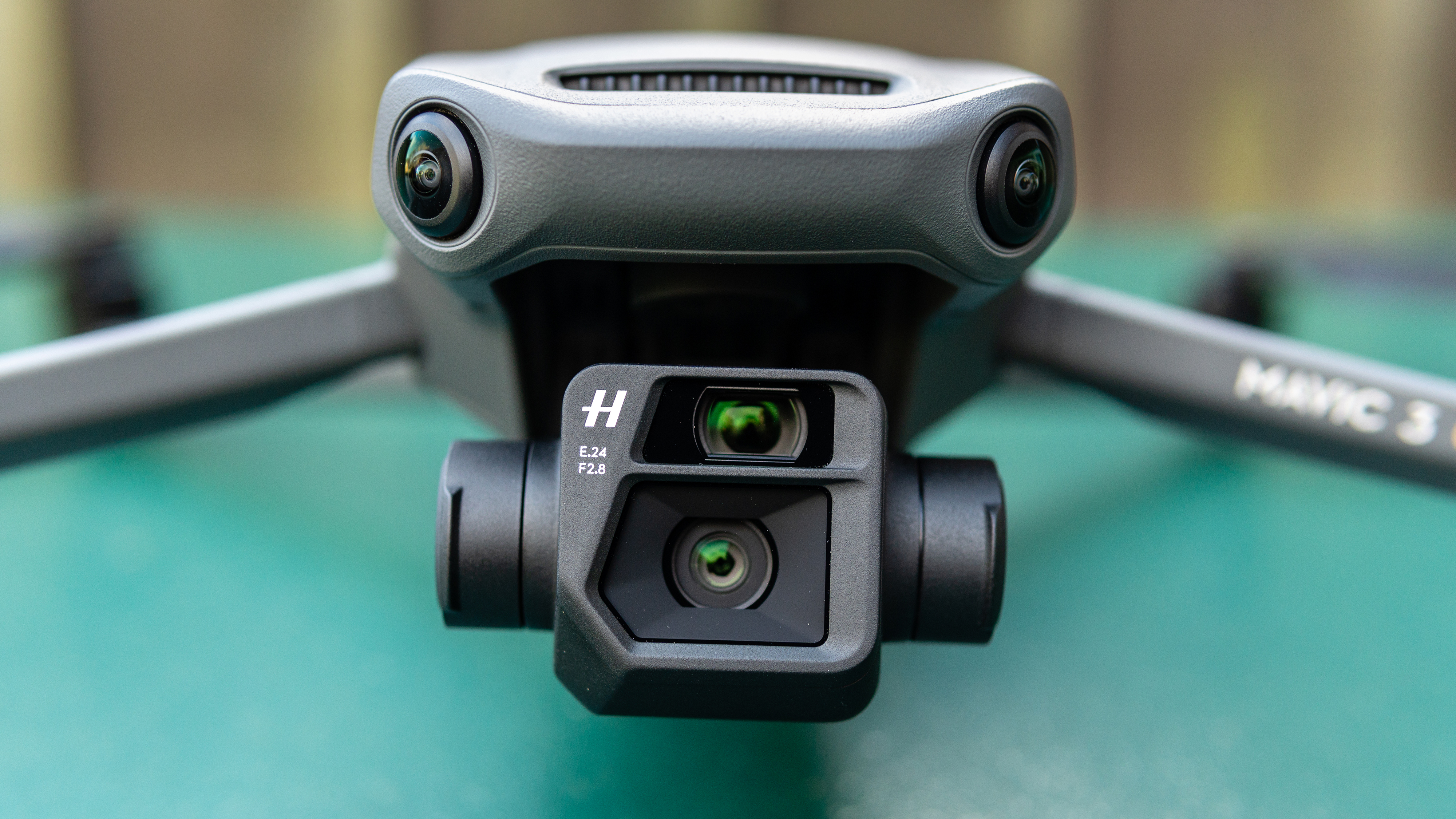
The improved video shooting powers of the Mavic 3 make it a significant upgrade on the Mavic 2 series, and pitch it more at professional photographers and videographers. It can shoot 5.1K video up to 50fps, 4K at up to 120fps, FHD up to 120fps when shooting Apple ProRes, and up to 200fps when using the H264/H.265 codecs, which includes D-Log (Raw).
The Mavic 3 offers improvements elsewhere, too, including improved responsiveness in flight and a better battery life, although we found real-world flight times to be closer to 30 minutes than the claimed 46 minutes. Despite all these upgrades, the Mavic 3's design matches its backpack-friendly predecessors, and the weight of both models has been kept below 900g. For Europe-based drone fans, this could help it achieve EU classification before the region's new drone rules come into play on January 1 2023. This isn't guaranteed, though, so is something consider.
Perhaps a bigger factor to bear in mind, wherever you're based, is that the DJI Mavic 3 is missing a few features at launch, including ActiveTrack 5.0 subject-tracking, MasterShots (its range of automated flight modes) and Wi-Fi QuickTransfer, which uses the Wi-Fi 6 protocol for speedier transferring of your photos and videos to your phone. DJI says these will all arrive with a firmware update on January 22, 2022.
None of these are deal-breakers or fundamental features for most pro fliers, but it's a shame they're missing at launch, particularly on such an expensive drone. Still, if image quality is your main priority, for both video and stills, the DJI Mavic 3 won't disappoint and is one of the best drones you can buy, despite its price tag and missing software tricks.
DJI Mavic 3 release date and price
You can order the DJI Mavic 3 today and in one of three kits. As always, there’s a Standard version, plus a Fly More Combo that offers a range of useful accessories (including two extra batteries) for a lower price than buying everything separately.
If you're feeling particularly flush, there's also the Cine Premium Combo, which sees the drone's storage bumped to 1TB and includes all of the Fly More Combo accessories, plus the new DJI RC Pro controller and two sets of ND filters.
The Mavic 3 Standard version costs US$2,199 / £1,879 / AU$3,099. This kit includes the Mavic 3 drone, one Intelligent Flight Battery, an RC-N1 Remote Controller, phone cables, a battery charger, storage cover and three pairs of propellers.
The DJI Mavic 3 Fly More Combo costs US$2,999 / £2,549 / AU$4199 and includes all of the above, plus two additional Intelligent Flight Batteries, three additional pairs of propellers, a battery charging hub, an ND Filter Set (ND4/8/6/32), and a convertible carrying bag.

The DJI Mavic 3 Cine Premium Combo, meanwhile, comes in at a whopping US$4,999 £4279 / AU$7199. This kit includes everything in the Fly More Bundle but the drone features a built-in 1TB SSD rather than 8GB of internal storage, and adds support for Apple ProRes 422 HQ video recording. Other additional accessories include a DJI RC Pro (with a built-in 5.5in screen) rather than the RC-N1 Controller, plus an additional ND Filter Set (ND64/128/256/512) and a DJI 10Gbps Lightspeed Data Cable.
The Mavic 3's Standard version and Fly More Combo cost almost 40% more than their Mavic 2 Pro equivalents did at launch, which suggests the Mavic 3 is more of a professional drone than a consumer model. The DJI Air 2S replaces the Mavic 2 Pro at the top of the consumer line with a 1-inch sensor, while the Mavic 3 features a Four Thirds sensor in the main camera.
Design and controller
The Mavic 3 follows the same design principles as previous Mavic drones. This means the propeller arms fold inwards to make the drone much smaller and more backpack-friendly when it's not in use, before folding out again in seconds when you're ready to get it airborne. Despite its darker paintjob, the Mavic 3 also has that distinctive, iconic Mavic look and build quality.
The folded dimensions of the Mavic 3 are 212×96.3x90.3mm, while its unfolded size is 347.5×283x107.7 mm. This makes it similar to the Mavic 2 Pro when folded, with the unfolded size being slightly larger.
The Mavic 3's take-off weight is 895g for the Standard version and 899g for the Cine version. This is actually lighter than the Mavic 2 Pro (907g), which is impressive considering the Mavic 3's battery is heavier and offers a higher capacity of 5,000mAh compared to Mavic 2’s 3850mAh battery. This time, the battery inserts into the back of the Mavic 3 body, rather than into the top.
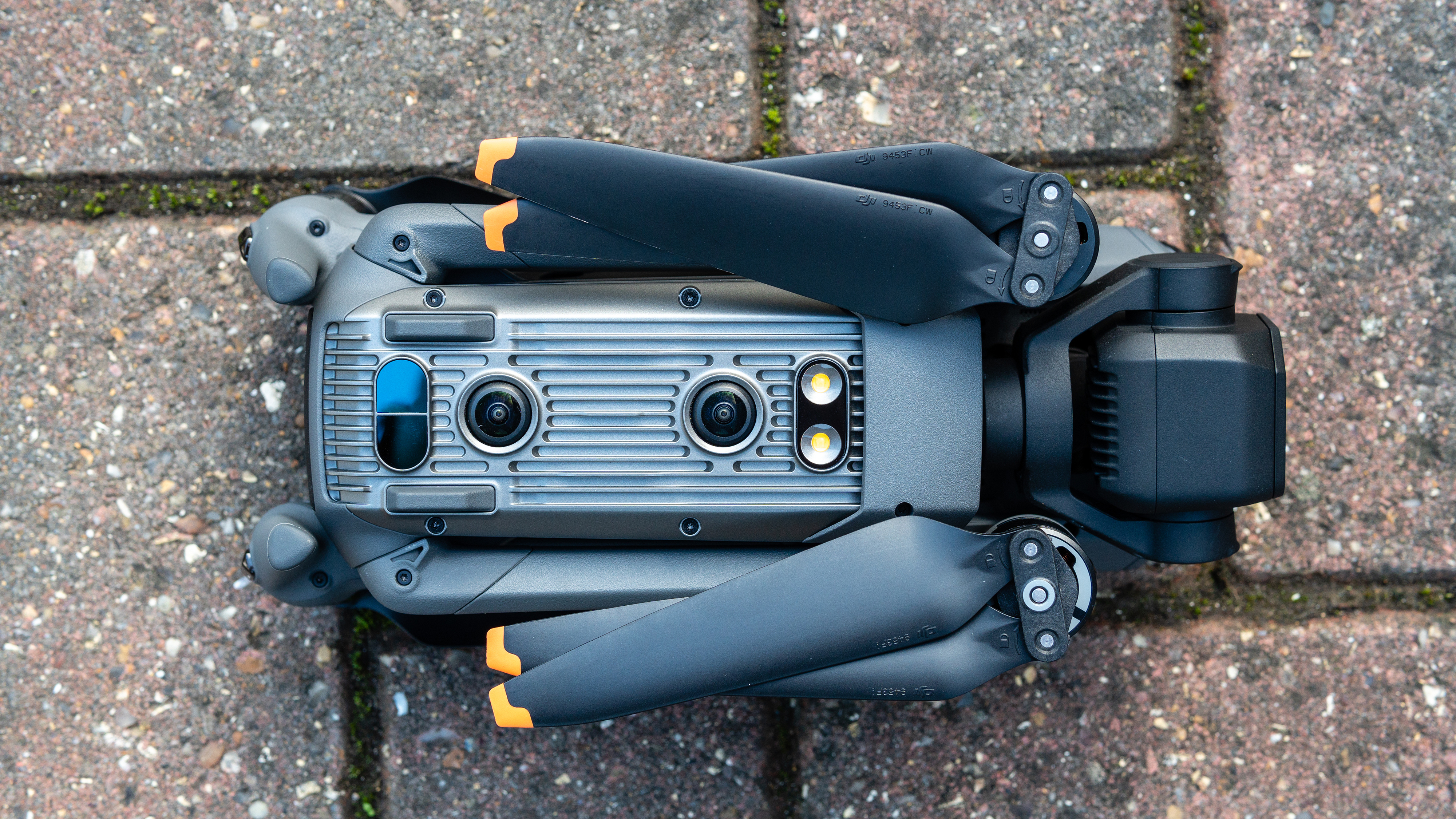
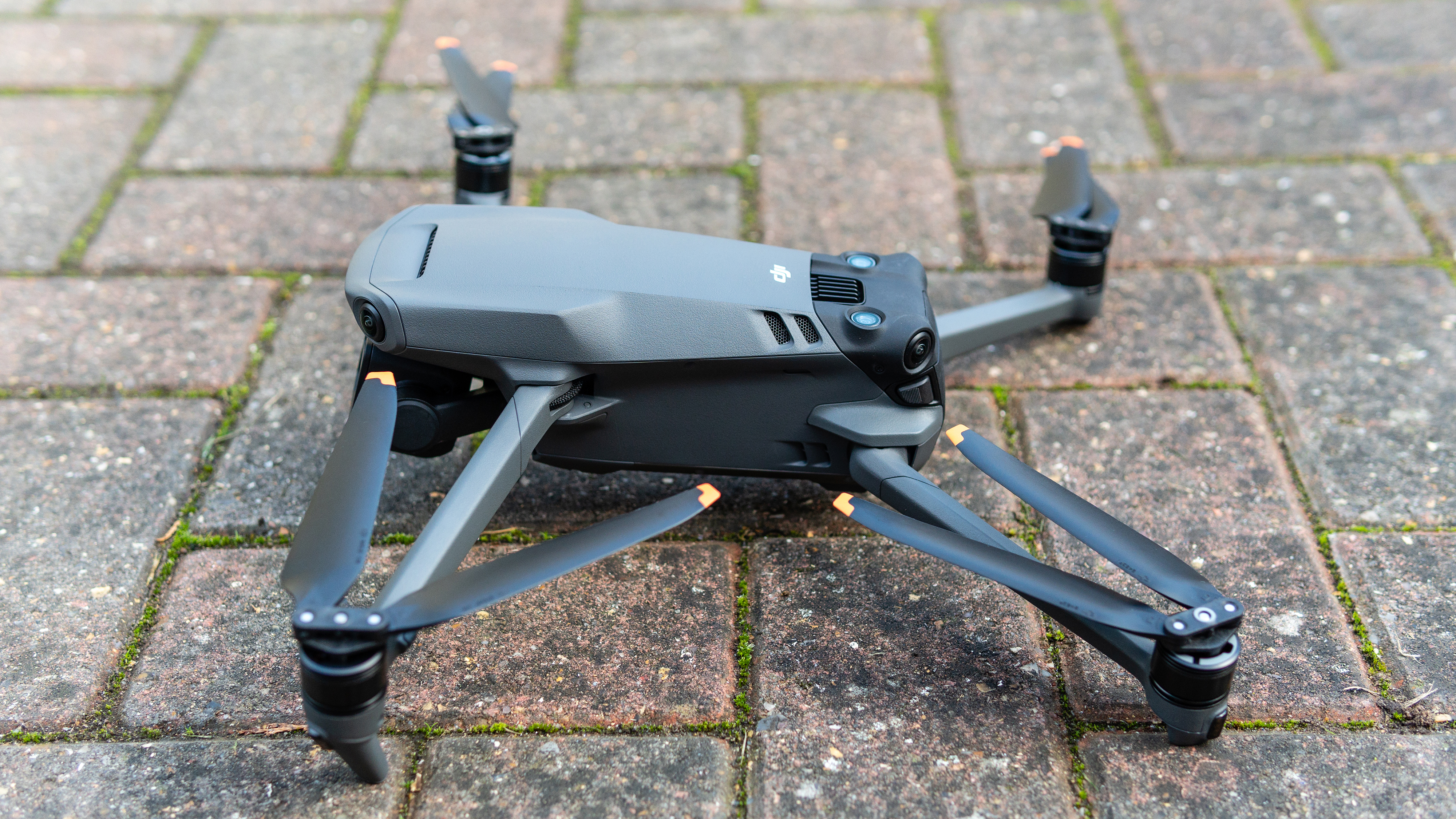
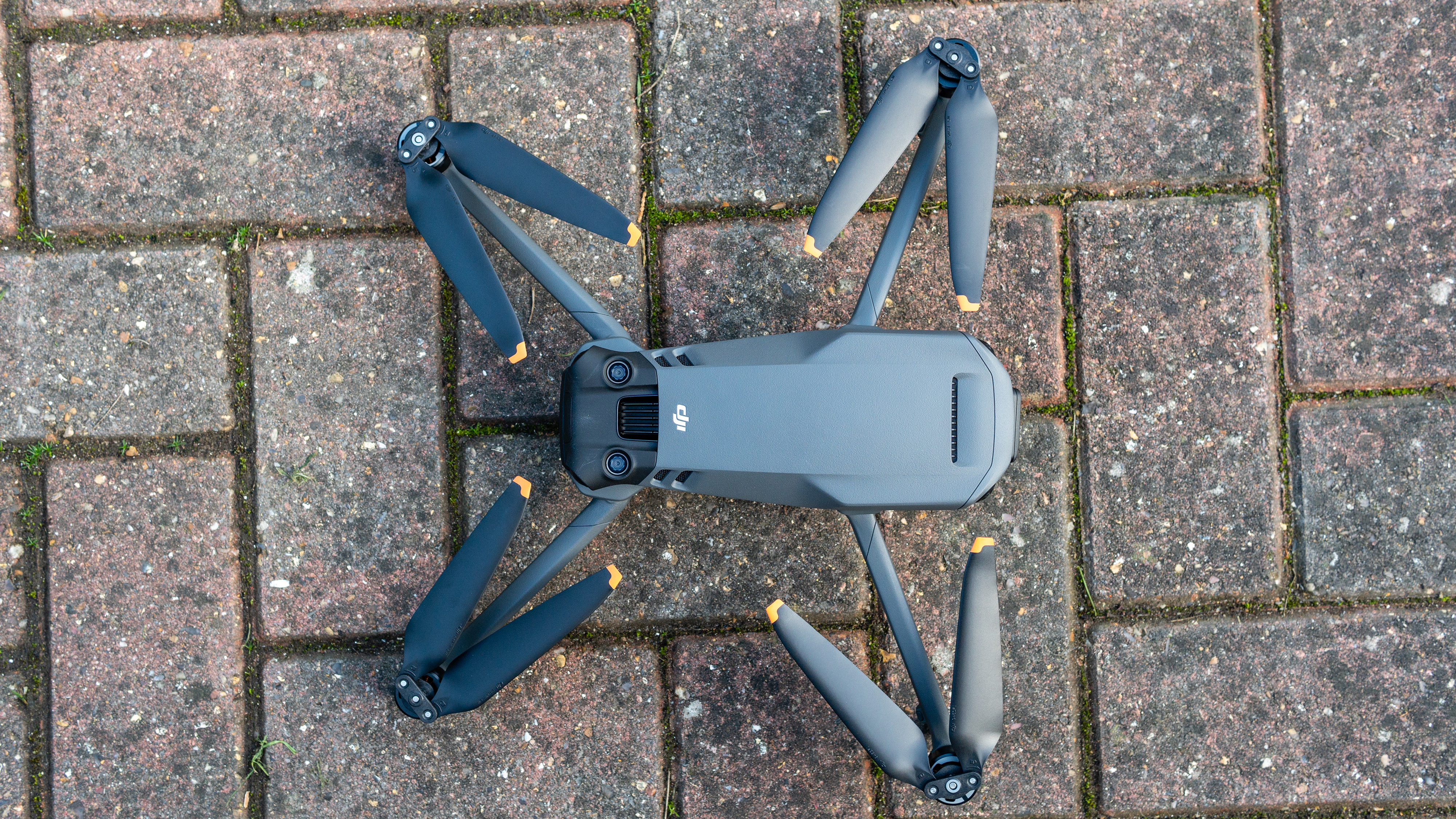
While the battery is a key player in the Mavic 3's improved flight time, some more efficient motors and propellers (alongside the drone's slightly reduced weight) help to increase flight times and provide a maximum speed of 47mph / 21m/s in Sport Mode.
But those aren't the only design improvements, with the shape of the drone, camera and propeller arms all streamlined to reduce drag, which DJI claims adds up to a 35% improvement compared to the Mavic 2 series. This is, of course, impossible to test, but flight times have certainly improved since the previous generation.
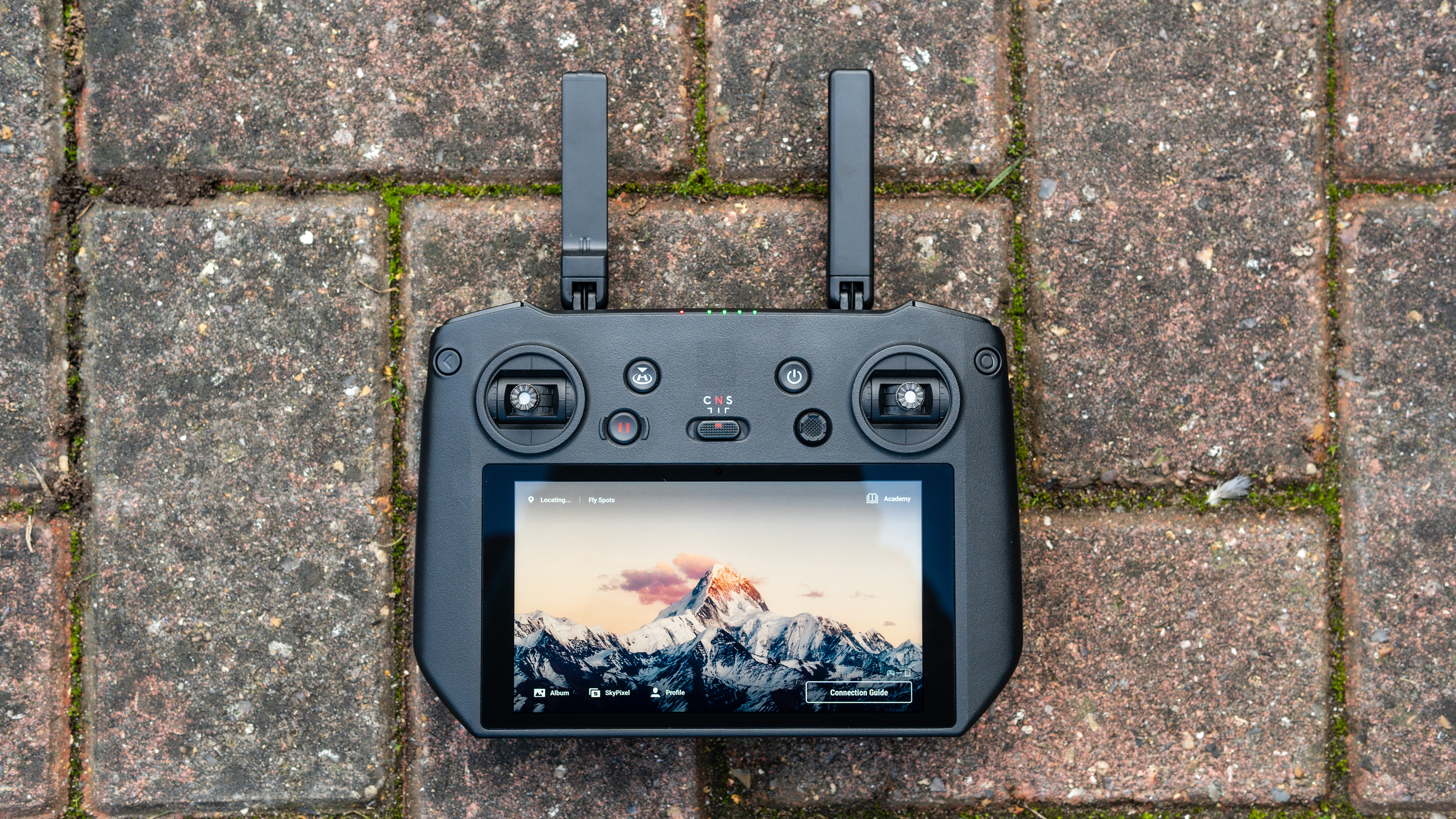
The standard controller that comes with the Standard version and Fly More Bundle is the same as the one you get with the DJI Mavic Air 2 and DJI Air 2S.
Unlike the Mavic 2 series' controller, this is a fixed size with a telescopic phone holder at the top of the unit where the phone cable can be stored, while the control sticks can be stowed away at the bottom on the controller when not in use. There’s no LCD screen showing flight information like on the Mavic 2 controller, which is a shame considering the higher price of the Mavic 3, but this information can be viewed within the DJI Fly app.
This controller is larger than the older foldable Mavic 2 controller, but the advantage is improved battery life of up to six hours. The RC Pro controller (above) that comes with the Cine version of the Mavic 3 is essentially a new Smart Controller with a 5.5in touchscreen and offers several other advanced features compared to the standard controller.
The main difference between the Standard and Cine versions of the Mavic 3 is that the Standard version provides 8GB of internal storage, while the Cine features an impressive 1TB SSD with support for Apple ProRes 422 HQ video recording.
Features and flight
The Mavic 3 is a nimble drone that’s much more responsive in flight than its Mavic 2 predecessors. In this respect, it's actually more like the DJI Phantom 4 Pro V2.0. The controls are simply much more sensitive in both Normal and Sport Modes, while Cine Mode offers reduced control sensitivity and speed for smoother flights and more cinematic video footage.
Flight is as nimble or subdued as you need it to be. While the Mavic 3's features and price make it more suited to experienced drone pilots and professional content creators, it could also serve as an entry-point for beginners thanks to its advanced safety features. Still, there are more suitable entry-level drones available, like the DJI Mini 2, and some amateur-friendly features (like the MasterShots automated flying modes) won't be available on the Mavic 3 until a firmware update on January 22, 2022.
In terms of safety features, the Mavic 3 uses multiple vision sensors to sense obstacles in all directions, which is extended up to 200m when Advanced 'Return To Home' (RTH) is initiated. It also offers improved obstacle avoidance in Advanced Pilot Assistance System (APAS) 5.0, which combines six fish-eye sensors and two wide-angle sensors to sense obstacles in all directions. When enabled, you can set the drone to fly autonomously around obstacles when detected to maintain continuous flight or to brake.
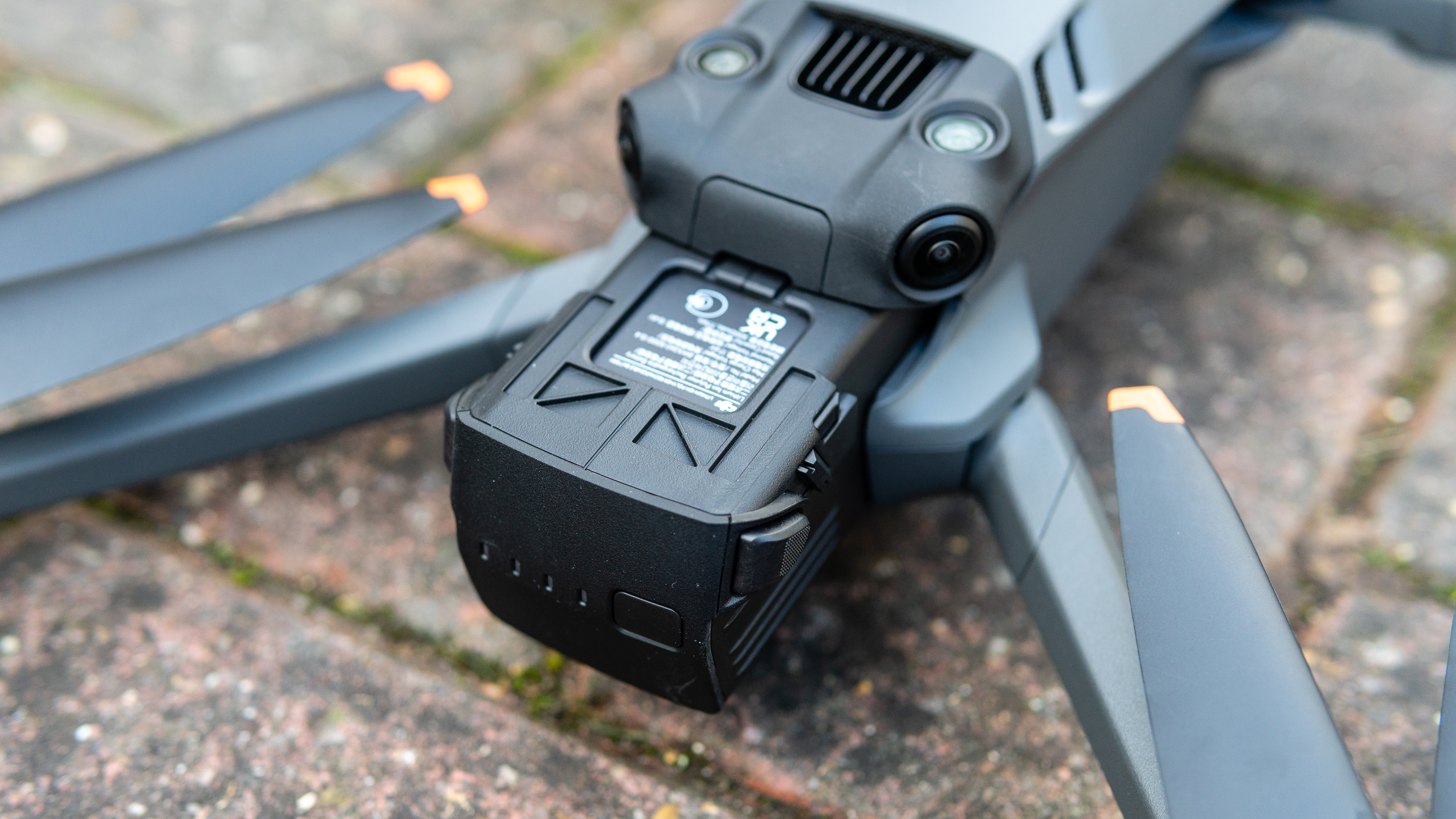
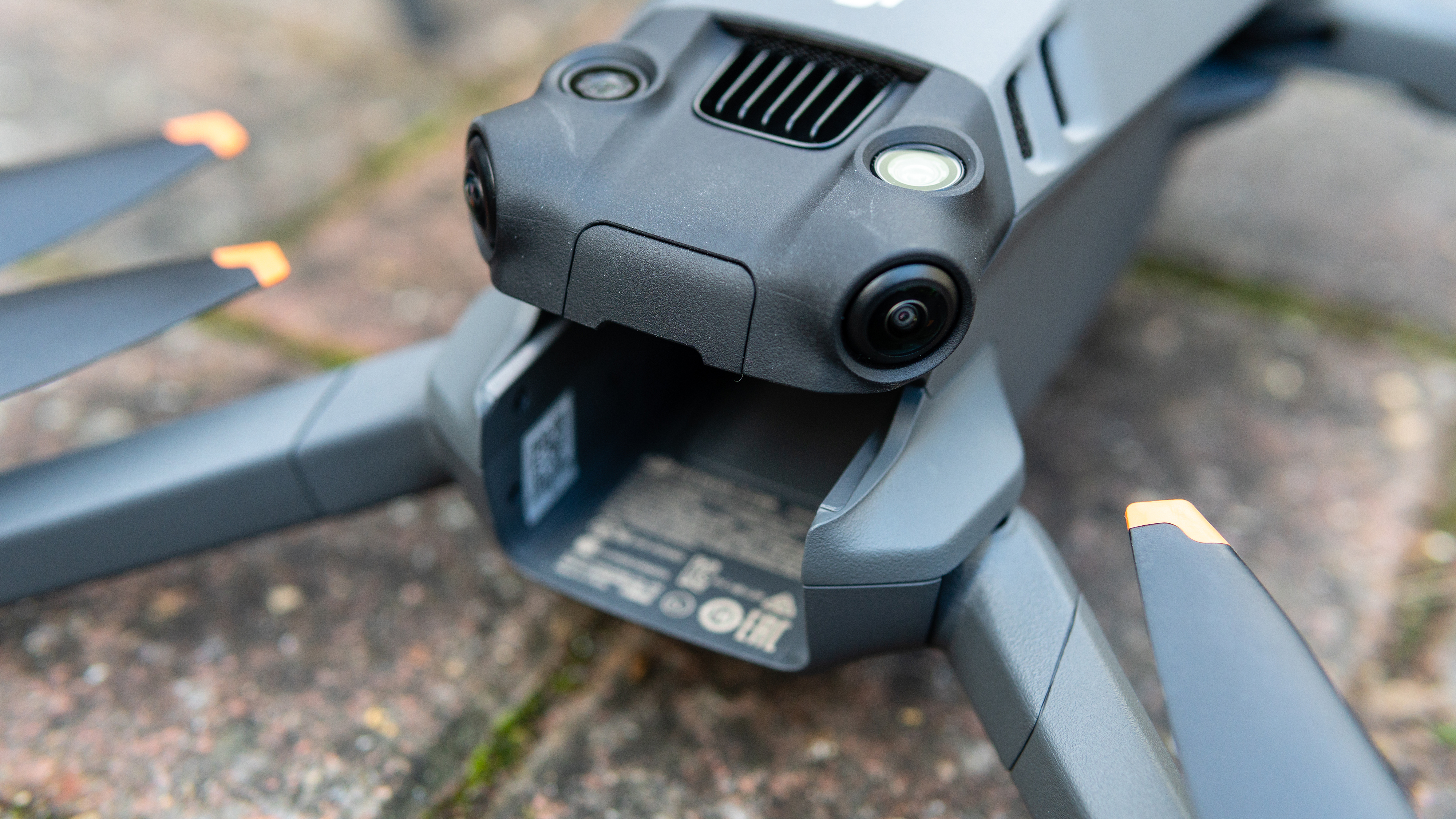
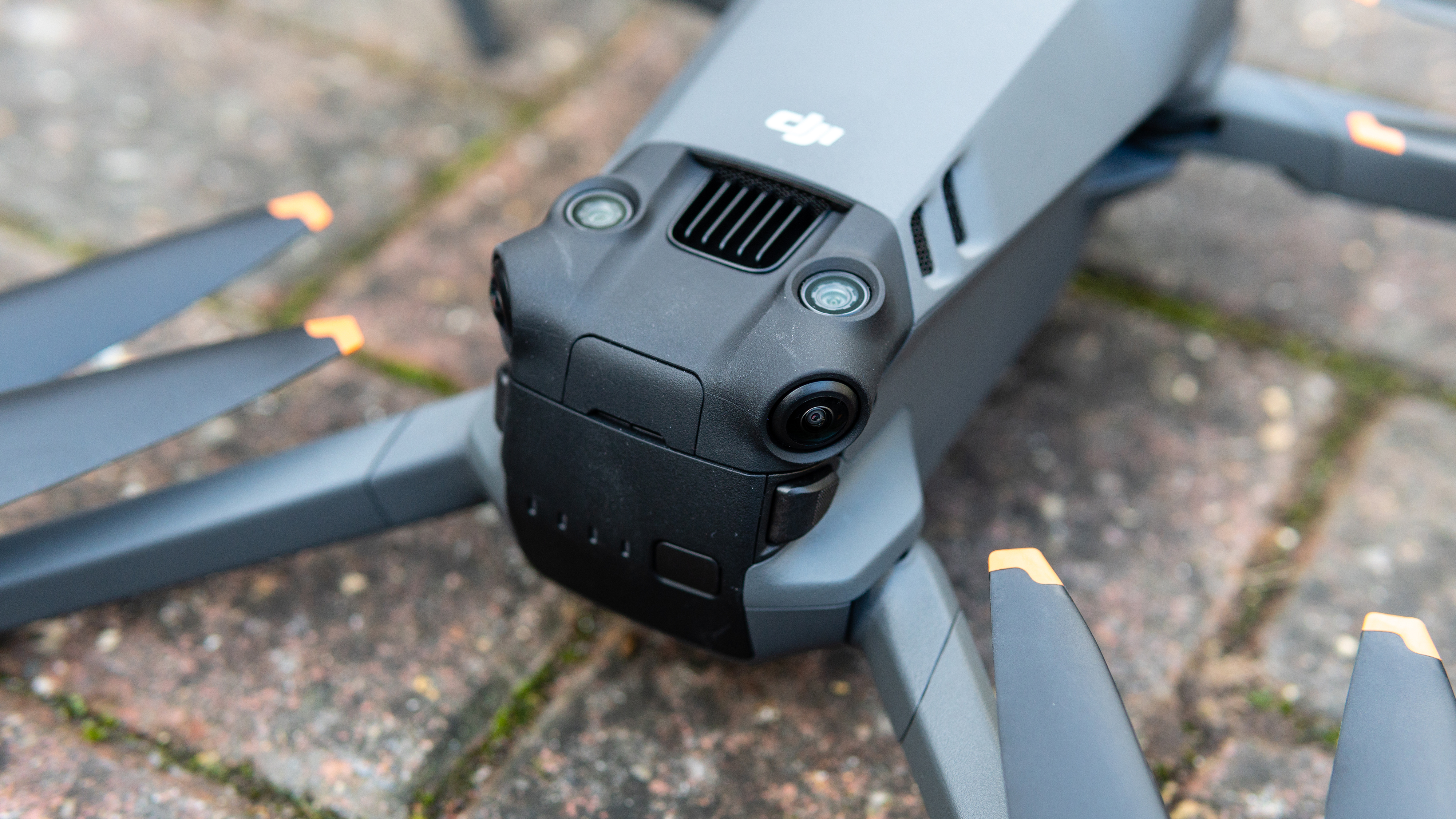
This works well in what you might call standard environments, but when flying in complex environments such as woodland, APAS can become overwhelmed and cause the drone to fly erratically. We tested this in a highly complex environment and the drone may have crashed into tree branches if it wasn’t stopped. Still, this was an incredibly tough test and when APAS was turned off, the drone was able to fly much more smoothly, albeit with a much greater risk of crashing.
Another feature that sits in the area of safety is the Mavic 3's new positioning algorithm, which claims to improve hovering precision with less drifting by connecting to GPS, GLONASS, and BeiDou satellites. This is, of course, welcome, but it’s impossible to see a difference between the Mavic 3 and previous-generation models when the drone is hovering.
DJI says the Mavic 3's new 5,000mAh battery provides a maximum flight time of 46 minutes or a distance of 30km (with no wind). In reality, this is never the case because you have to factor in wind, ambient temperature and the minimum battery charge before 'Return To Home' is initiated, so the advertised flight time is rarely possible. During testing, the battery did last well even in cold and windy conditions, but it was closer to 30 minutes before the drone suggested RTH.

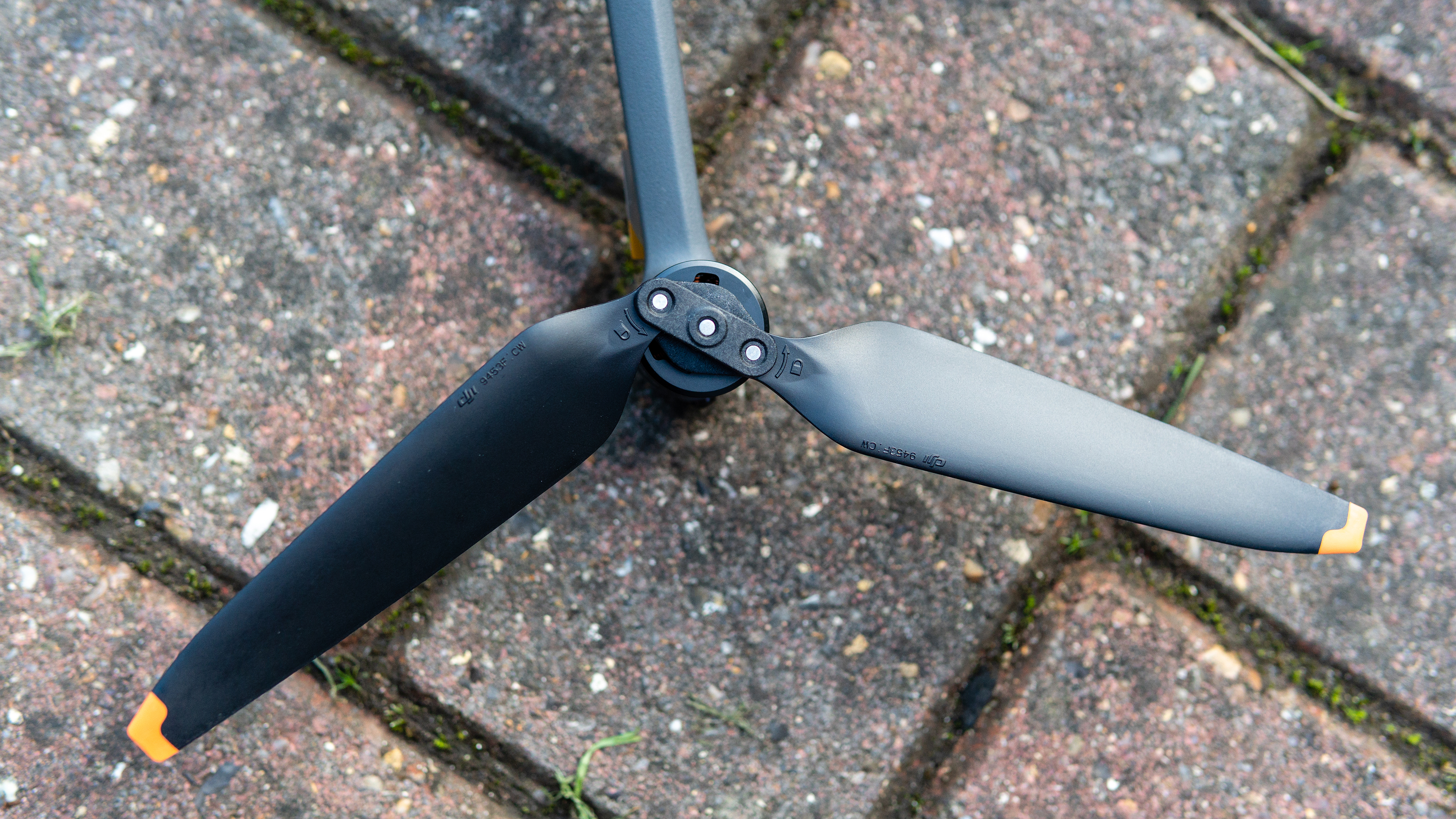
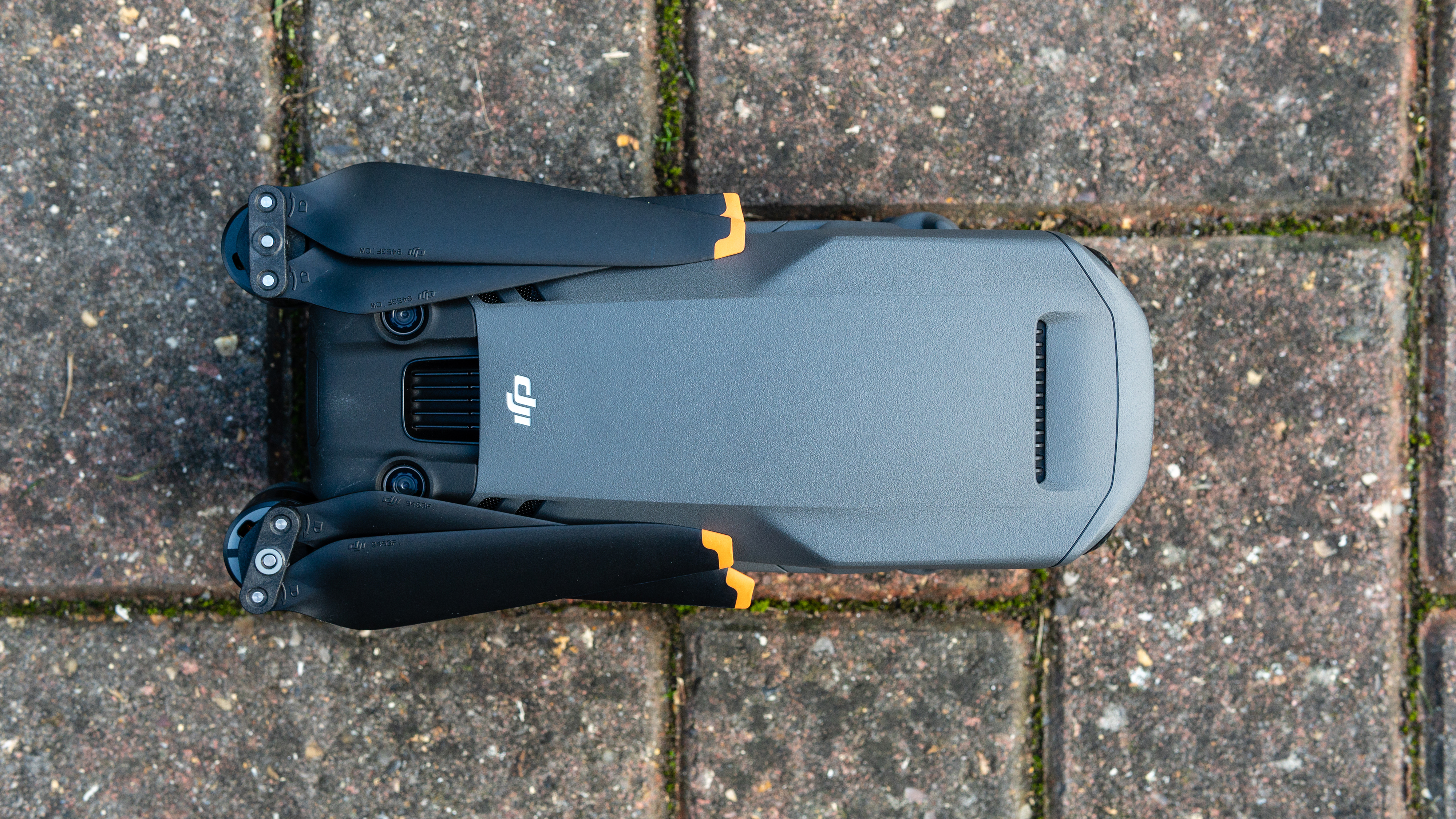
Flight and safety aside, the Mavic 3 uses the omnidirectional obstacle sensing system to improve subject tracking with the upgraded ActiveTrack 5.0 (coming in the January 2022 firmware update). This and QuickShots were unavailable in the pre-release firmware in our review sample, but we'll update this review as soon as they arrive.
QuickShots is a set of automated flight patterns for creating professional-looking videos with ease and includes Rocket, Circle, Dronie, Helix, Boomerang and Asteroid. There’s also a Hyperlapse mode for creating time-lapse and hyper-lapse videos alongside panoramic modes, single shot, automatic exposure bracketing and timed shots for stills. This is all alongside auto, aperture priority, shutter priority and manual shooting modes for both stills and video.
Other features include 'Trimmed Download', where you can select part of a video clip to download rather than the whole file, and QuickTransfer, which will allow you to store and process content on your smartphone using Wi-FI 6 to link to the drone.
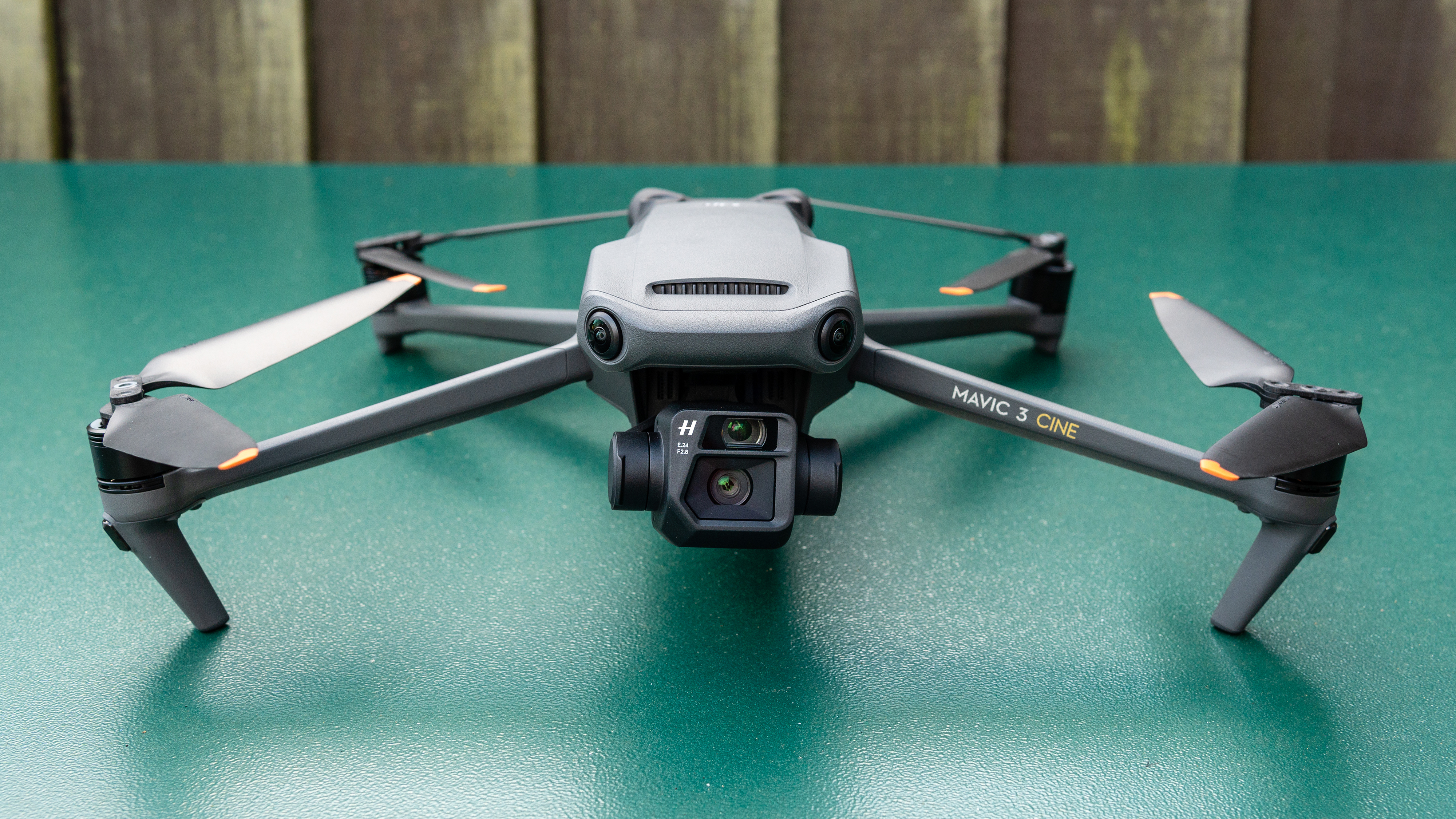
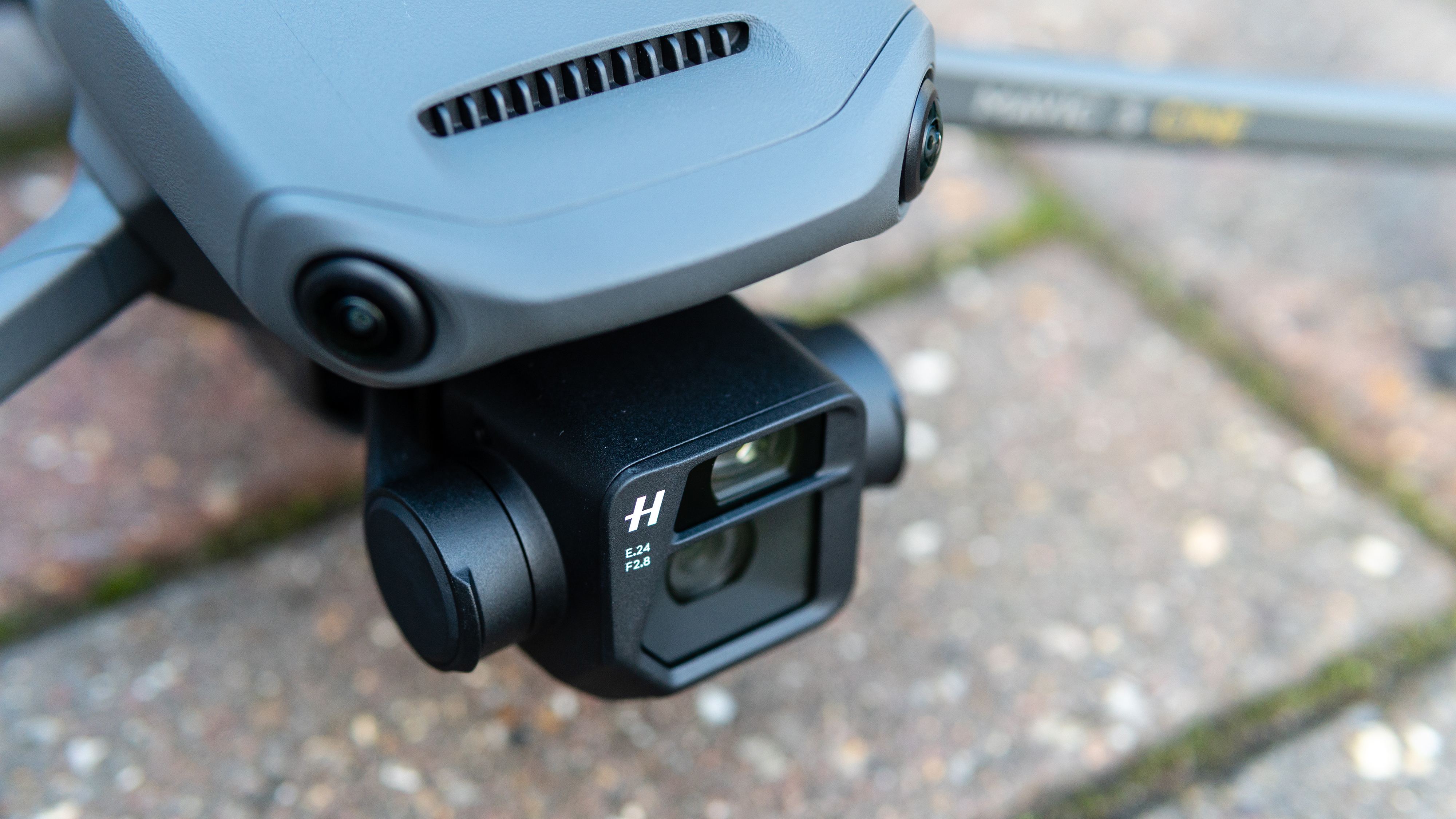
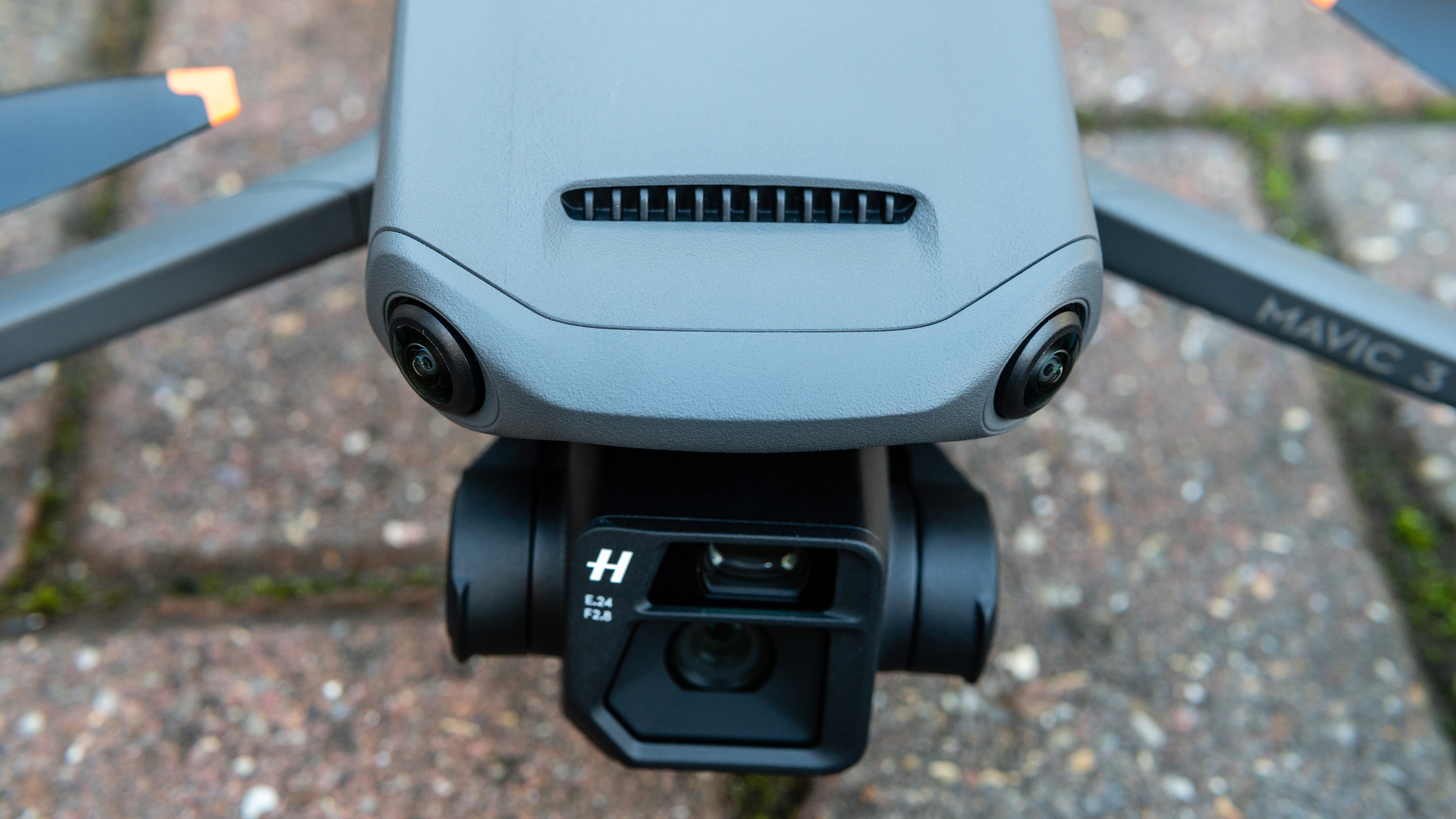
Video and photo quality
The jewel in the crown of the Mavic 3 is its dual Hasselblad camera, with the main camera featuring a 20MP Four Thirds CMOS sensor and an equivalent focal length of 24mm.
This camera, like the Mavic 2 Pro, offers an adjustable f/2.8 to f/11 aperture with auto and manual focus from 1m to infinity. The second camera features a 1/2-inch CMOS sensor with an equivalent focal length of 162mm, a fixed f/4.4 aperture and a 28x hybrid zoom.
Image quality from the main camera for stills and video is nothing short of excellent overall, with just a small amount of sharpness falling off at the edges of the frame when viewing stills. But the level of fall-off is minimal, and you have to look for it. It's also much better than the fall-off visible in DJI Air 2S' images.
Even in high-contrast scenes, no chromatic aberration was visible along subject edges and high ISO noise handling is also excellent, with usable results throughout the entire range, even if light grain does begin to become noticeable at ISO 800.





The Mavic 3's adjustable aperture is more useful for controlling exposure than depth-of-field, because the Four Thirds sensor is still small compared to a full-frame camera. But the ability to control the aperture is a fantastic feature when shooting video, since you can make exposure changes quickly in the air when the shutter speed needs to remain at a specific setting.
The Mavic 3's second camera is much more limited and can only shoot images in JPEG and standard video (not raw) at 4K 30fps. This hybrid camera only offers basic functionality and Auto shooting, with the ability to view distant scenes with ease.
Despite the limitations, it certainly has some real-world applications, and the ND filters available in the Fly More Bundle and Cine Premium Combo fit over both camera lenses, so there is some scope to control shutter speed when shooting video. The image quality when zooming in does, however, diminish significantly the further you zoom in, so don’t expect to be able to capture high-quality imagery at the higher zoom levels.
Should I buy the DJI Mavic 3?

Buy it if...
You need excellent, pro-level image quality
The Mavic 3 is undoubtedly the class leader in image quality thanks to its Four Thirds sensor. Noise handling at Higher ISO settings is also excellent, making this a compelling option for stills photographers producing aerial stills commercially.
You’re a professional videographer
The Cine version is extremely expensive, but for working pros, cost isn’t always the deciding factor – and the Mavic 3 is still more cost-effective than the DJI Inspire 2. Being able to shoot Apple ProRes video to a 1TB internal SSD on such a small drone is amazing.
You own a DJI Mavic 2 Pro
The Mavic 2 Pro has been around for a few years now, and even the DJI Air 2S is a strong competitor, despite its lack of adjustable aperture. But the Mavic 3 is leaps and bounds ahead of the Mavic 2 Pro and the improvements in image quality will make the purchase worth it.
Don't buy it if...
You’re on a budget and want a super-compact drone
With all of its new features, including those dual cameras, it isn't surprising to see that the cost of the Mavic 3 has increased significantly when compared to the Mavic 2 series. If you’re on a budget and looking to travel light, you'll be better off with the DJI Air 2S.
You recently bought the DJI Air 2S
If you recently bought the DJI Air 2S, you already have an amazing drone. While it’s not as good as the Mavic 3, it is considerably lighter and more portable. If you find the image quality lacking for your needs, wait for the price of the Mavic 3 to come down or look for special offers during shopping events like Black Friday.
You already use a Mavic 2 Zoom
While the Mavic 3 offers a telephoto lens with hybrid 24x zoom, the quality of the higher zoom levels coupled with the limited controls won’t replace the higher quality possible with the Mavic 2 Zoom. Maybe firmware updates will improve this, but at the moment there's still very much a place for this older Mavic model.
- These are the best drones you can buy right now
0 comments:
Post a Comment